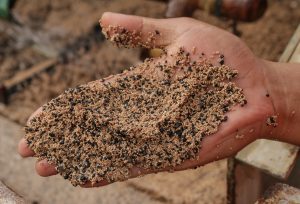
24 Mar The RECYN History
RECYN HISTORY
 Cyanide was first used in the 19th Century and has not been replaced in the 21st Century. More than 50 years ago, resin was proposed as an adsorbent to reduce free and metal complexed cyanides from
Cyanide was first used in the 19th Century and has not been replaced in the 21st Century. More than 50 years ago, resin was proposed as an adsorbent to reduce free and metal complexed cyanides from
gold plant tailings.
The author of this paper has been involved in the development of the resin technology for the last 30 years, initially with the Vitrokele process. This is a classic case of the challenges of technology commercialization. The answer has been persistence.
Vitrokele
A serious attempt at commercialization of a resin based system was undertaken by Tallon and Signet Engineering in the 80’s and early 90’s. The technology, known as Vitrokele, was focused on the replacement of carbon for metal recovery.
A major effort was applied to continuous piloting of the technology at mine site locations in Australia and Canada. The results gave confidence in the process and chemistry prior to commercial application.
A total of four commercial applications were constructed over a five year period:
- The technology was first applied very successfully at Connemara in Zimbabwe on a gold heap leach project. It was successful because the ore did not have any significantly soluble base metals.
- The second commercial application was at Avocet’s Penjom project in Malaysia. Penjom had encountered significant preg-robbing ore, causing a dramatic reduction in gold recovery in their CIL circuit. The addition of kerosene overcame the pre-robbing but contaminated the carbon. Resin was not affected by kerosene and was therefore a good substitute for carbon. Signet converted the CIL circuit to an RIL circuit using Vitrokele resin. The resin proved impervious to kerosene, but not to copper. The copper occupied gold sites and substantially reduced the resin activity. Penjom then changed to a gold-specific resin having been convinced that resin was a practical viable alternative.
- The third commercial project for Vitrokele was the MayDay project for Jason Mining. This was a small vat leach project that also had high soluble copper levels. Many aspects of the technology were proven at this project, but copper again proved to be the downfall. There was an inadequate copper removal circuit, even though this was a standard part of the technology, proven at pilot plant level. Again the focus was on gold recovery. The focus on metal recovery consequently had a major negative impact on Vitrokele technology.
- The fourth and final attempt at commercial application of the technology was in 1998 at the Mirah Gold/Silver Project in Indonesia. In this instance the focus of the technology was reversed and cyanide recovery and detoxification became the main objective. Carbon was retained as the primary metal recovery process. The introduction of a cyanide recovery process made the project economically viable, as it was previously marginal. Unfortunately for the technology, the Mirah Project was not commissioned as scheduled due to the 1998 Asian Financial Crisis. It was two months away from commissioning, but then sat in the Borneo jungle for the next 14 years.
These factors, combined with the untimely passing of two of the main protagonists of the technology, resulted in the Vitrokele technology being abandoned.
Alternatives
For the past 15 years, other research groups have persisted with resin based variants of the Vitrokele process, but no commercial process has eventuated. There has been a similar focus on finding alternatives to cyanide, in the hope they will be more environmentally acceptable. Again nothing has emerged as a serious contender.
So what is the answer?
Simply accept cyanide as the superior solvent and address the concerns: Hence, the RECYN process.



Sorry, the comment form is closed at this time.